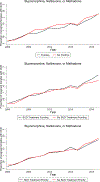Impact of prenatal substance use policies on commercially insured pregnant females with opioid use disorder
- PMID: 35577664
- PMCID: PMC9357143
- DOI: 10.1016/j.jsat.2022.108800
Impact of prenatal substance use policies on commercially insured pregnant females with opioid use disorder
Abstract
Introduction: States' approaches to addressing prenatal substance use are widely heterogeneous, ranging from supportive policies that enhance access to substance use disorder (SUD) treatment to punitive policies that criminalize prenatal substance use. We studied the effect of these prenatal substance use policies (PSUPs) on medications for opioid use disorder (OUD) treatment, including buprenorphine, naltrexone, and methadone, psychosocial services for SUD treatment, opioid prescriptions, and opioid overdoses among commercially insured pregnant females with OUD. We evaluated: (1) punitive PSUPs criminalizing prenatal substance use or defining it as child maltreatment; (2) supportive PSUPs granting pregnant females priority access to SUD treatment; and (3) supportive PSUPs funding targeted SUD treatment programs for pregnant females.
Methods: We analyzed 2006-2019 MarketScan Commercial Claims and Encounters data. The longitudinal sample comprised females aged 15-45 with an OUD diagnosis at least once during the study period. We estimated fixed effects models that compared changes in outcomes between pregnant and nonpregnant females, in states with and without a PSUP, before and after PSUP implementation.
Results: Our analytical sample comprised 2,438,875 person-quarters from 164,538 unique females, of which 13% were pregnant at least once during the study period. We found that following the implementation of PSUPs funding targeted SUD treatment programs, the proportion of opioid overdoses decreased 45% and of any OUD medication increased 11%, with buprenorphine driving this increase (13%). The implementation of SUD treatment priority PSUPs was not associated with significant changes in outcomes. Following punitive PSUP implementation, the proportion receiving psychosocial services for SUD (12%) and methadone (30%) services decreased. In specifications that estimated the impact of criminalizing policies only, the strongest type of punitive PSUP, opioid overdoses increased 45%.
Conclusion: Our findings suggest that supportive approaches that enhance access to SUD treatment may effectively reduce adverse maternal outcomes associated with prenatal opioid use. In contrast, punitive approaches may have harmful effects. These findings support leading medical organizations' stance on PSUPs, which advocate for supportive policies that are centered on increased access to SUD treatment and safeguard against discrimination and stigmatization. Our findings also oppose punitive policies, as they may intensify marginalization of pregnant females with OUD seeking treatment.
Keywords: Maternal health; Opioid use disorder; Pregnancy; Prenatal substance use policies.
Copyright © 2022 The Authors. Published by Elsevier Inc. All rights reserved.
Figures
Similar articles
-
Comparative Effectiveness Associated With Buprenorphine and Naltrexone in Opioid Use Disorder and Cooccurring Polysubstance Use.JAMA Netw Open. 2022 May 2;5(5):e2211363. doi: 10.1001/jamanetworkopen.2022.11363. JAMA Netw Open. 2022. PMID: 35536575 Free PMC article.
-
Services for perinatal patients with opioid use disorder: a comprehensive Baltimore City-wide 2023 assessment.Addict Sci Clin Pract. 2024 Oct 15;19(1):73. doi: 10.1186/s13722-024-00507-0. Addict Sci Clin Pract. 2024. PMID: 39407344 Free PMC article.
-
Polysubstance use and association with opioid use disorder treatment in the US Veterans Health Administration.Addiction. 2021 Jan;116(1):96-104. doi: 10.1111/add.15116. Epub 2020 Jul 7. Addiction. 2021. PMID: 32428386
-
Treating Women Who Are Pregnant and Parenting for Opioid Use Disorder and the Concurrent Care of Their Infants and Children: Literature Review to Support National Guidance.J Addict Med. 2017 May/Jun;11(3):178-190. doi: 10.1097/ADM.0000000000000308. J Addict Med. 2017. PMID: 28406856 Free PMC article. Review.
-
Progress in agonist therapy for substance use disorders: Lessons learned from methadone and buprenorphine.Neuropharmacology. 2019 Nov 1;158:107609. doi: 10.1016/j.neuropharm.2019.04.015. Epub 2019 Apr 19. Neuropharmacology. 2019. PMID: 31009632 Free PMC article. Review.
Cited by
-
Commentary on Schmidt et al.: Informed patient preference and prioritizing access to medications for opioid use disorder for pregnant individuals.Addiction. 2024 Jun;119(6):1123-1124. doi: 10.1111/add.16495. Epub 2024 Apr 3. Addiction. 2024. PMID: 38570825 Free PMC article. No abstract available.
-
Relationship between mandatory warning signs for cannabis use during pregnancy policies and birth outcomes in the Western United States.Prev Med. 2022 Nov;164:107297. doi: 10.1016/j.ypmed.2022.107297. Epub 2022 Oct 10. Prev Med. 2022. PMID: 36228875 Free PMC article.
-
The Hypocritical Oath? Unintended Consequences of Prenatal Substance Use Policies and Considerations for Health Care Providers.J Perinat Neonatal Nurs. 2024 Oct-Dec 01;38(4):414-419. doi: 10.1097/JPN.0000000000000836. Epub 2024 Nov 7. J Perinat Neonatal Nurs. 2024. PMID: 39527551
-
Informing evidence-based medicine for opioid use disorder using pharmacoeconomic studies.Expert Rev Pharmacoecon Outcomes Res. 2024 Jun;24(5):599-611. doi: 10.1080/14737167.2024.2350561. Epub 2024 May 9. Expert Rev Pharmacoecon Outcomes Res. 2024. PMID: 38696161 Free PMC article. Review.
-
Challenges for Antepartum Care of the Individual with Perinatal Substance Use: An Empirical Integrative Review of Novel Approaches to Improve Care.J Midwifery Womens Health. 2024 Nov-Dec;69(6):863-874. doi: 10.1111/jmwh.13714. Epub 2024 Nov 27. J Midwifery Womens Health. 2024. PMID: 39604068 Free PMC article. Review.
References
-
- Administration for Children and Families. (2021). State statutes search. Child Welfare Information Gateway: Definitions of Child Abuse and Neglect. https://www.childwelfare.gov/topics/systemwide/laws-policies/state/?CWIG....
-
- Angelotta C, Weiss CJ, Angelotta JW, & Friedman RA (2016). A moral or medical Problem? The relationship between legal penalties and treatment practices for opioid use disorders in pregnant females. Women’S Health Issues : Official Publication of the Jacobs Institute of Women’S Health, 26(6), 595–601. 10.1016/j.whi.2016.09.002 - DOI - PubMed
-
- Ashley OS, Marsden ME, & Brady TM (2003). Effectiveness of substance abuse treatment programming for women: A review. The American Journal of Drug and Alcohol Abuse, 29(1), 19–53. - PubMed
-
- Atkins DN, & Durrance CP (2020). State policies that treat prenatal substance use as child abuse or neglect fail to achieve their intended goals: Study examines the effect of state policies that treat prenatal substance use as child abuse or neglect on the incidence of neonatal abstinence syndrome and other factors. Health Affairs, 39(5), 756–763. - PubMed
Publication types
MeSH terms
Substances
Grants and funding
LinkOut - more resources
Full Text Sources
Medical


